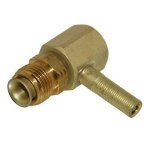achris
More fish than mountain goat
- Joined
- May 19, 2004
- Messages
- 27,468
...I was also reading in some other forums, etc., that if there is a vacuum leak somewhere, than you can get similar symptoms.
A stuck IAC is a vacuum leak.
Chris......















...I was also reading in some other forums, etc., that if there is a vacuum leak somewhere, than you can get similar symptoms.

Ted, I am kinda surprised that a healthy cooling system wouldn't be able to handle lean running (and maintain temp etc)
I didn't see if you checked, but did you visually verify that your oil cooler is not partially blocked?
When I installed my 7.4L Bravo, I found the oil cooler clogged with debris from a previous impeller failure. BUT, I still had to use needle-nose pliers to pull out all the pieces. Backflushing would not dislodge them.
Funing thing though, when I asked the previous owner, he said he changed the impeller (and it looked more or less "ok ) and said he didn't have any overheating problems.........
Wondering if I should get a couple of IAC's to see if that straightens things out. It would be about $200, ....
If you buy genuine, yes. https://www.summitracing.com/int/par.../model/montana and pay $29 each.
BTW, in your Diacom software you have an IAC test page. Just run the test and you'll know if they are working properly.
Chris......
... but that is the folk lore on the Internet :noidea:
If it's on the internet, it must be true. :facepalm:
Timing will cause engines to run hotter..... But a marine cooling system (with excessive cooling capacity AND a thermostat) it seems that the additional heat would be "taken-care" of by that cooling system.Just wondering though if anyone has direct experience/knowledge of retarded timing (i.e. not advanced enough) causing the engine to run hotter??? supposedly it exposes the cylinder head & exhaust ports to too much of the burning cycle and raises the heat of the engine. Not sure about the thermodynamics of it all, but that is the folk lore on the Internet :noidea:
The main thing that is guiding me to look at the engine is the lean burn looking spark plugs as well as the Diacom status indicating a Lean condition.